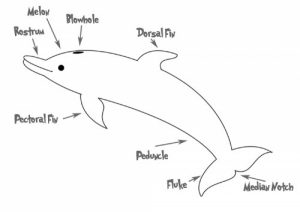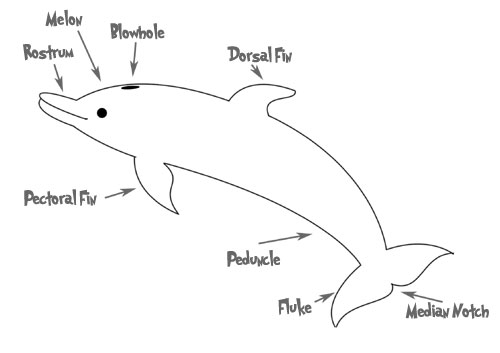
[ms_audio style=”light” mp3=”https://www.dolphincommunicationproject.org/wp-content/uploads/2022/05/TheDolphinPod-2006-09-25-46453.mp3″ ogg=”” wav=”” mute=”” loop=”” controls=”yes” class=”dcp-embed-mp3″ id=””]
Here is a news flash: dolphins do not have arms or legs! OK, OK, so that is hardly news. Surely everyone knows that dolphins have flippers instead of arms. Or, is it flippers instead of legs? Or, are they called fins? Fins, flippers… uh oh, what exactly are all those special dolphin appendages called?
This sounds like a job for “Dolphin Anatomy Terminology Man”.
Wherever there is improper vocabulary use, he’ll be there…
‘Hey mommy, look at the dolphin’s snout’ – ‘Stop right there, young man, that’s not called a snout: that is the dolphin’s rostrum. And remember; accurate anatomical terminology is cool’
Wherever layman language hinders the proper identification of body parts, he’ll be there:
‘I heard that a dolphin breathes through a nose on the top of its head’ – ‘No son, it’s not called a nose, it is in fact termed a blowhole. And remember; accurate anatomical terminology is cool’
OK, I have to admit that Dolphin Anatomy Terminology Man sounds desperately boring as far as superheroes go. So, let’s put him back on the shelf, and I’ll provide you with a ‘super’ easy list of unique body parts that dolphins have:
First, let’s start with this pesky fin/flipper problem. The word ‘flipper’ is a kind of general term that some people use to describe many different parts of a dolphin’s body, but correct terminology for a dolphin’s body does not make use of the word flipper at all. Those flippers on the side of the dolphin’s body are actually called pectoral fins or, for those scientists in a hurry; pec fins. The word ‘pectoral‘ comes from the Latin word meaning chest or breast. So, pec fins are, in a way, chest fins.
Interestingly, the dolphin pectoral fin is homologous to our own hand and arm bones. It you took an X-ray of the dolphin pectoral fin, you would see shortened bones that resembled our fingers, forearm, and upper arm.
The fin on the top of the dolphin’s body is called the dorsal fin. The word ‘dorsal‘ comes from another Latin word meaning ‘back’. Not all dolphin species have a visible dorsal fin – in the absence of a distinct fin, this area is called the dorsal ridge.
A dolphin’s tail is actually made up of a variety of different parts. The tail stock is called the peduncle. The peduncle flattens out into two halves which are called flukes. The flat end of the tail consists of two flukes – the left fluke and the right fluke. Where the two flukes meet in the middle is usually called the median notch.
As you can see, there are in fact no flippers on a dolphin at all!
Heading underneath the dolphin, you will notice that they don’t have any visible genitalia. For male dolphins, the genitals are tucked up safe and sound inside, but sometimes make an appearance through an area of the dolphin’s belly called the genital slit. Female dolphins have two slits on either side of their genital slit where the mammary glands can be found.
Heading back to the front end of the dolphin, we are faced with problem of what to call the dolphin’s long ‘nose’. Many people call this long “nose”, consisting of the lower and upper jaw, a ‘beak’ or ‘snout’, but its proper name is in fact ‘rostrum‘, as Dolphin Anatomy Terminology Man pointed out earlier. Although a variety of words will crop up to describe the rostrum (like beak), and none of them are incorrect per se, you will always be correct if you refer to a dolphin’s beak as a rostrum. Dolphins that don’t have a distinct protruding rostrum (like the killer whale) are sometimes described as having a ‘blunt’ rostrum.
Sticking with the head, the word ‘melon‘ is used to describe the rounded front part of a dolphin’s forehead. The melon contains a fatty substance nicknamed “acoustic fat” that the dolphin uses to direct their echolocation beam. This acoustic fat has the same density as seawater, making it easy for sound waves to pass through the melon into the water. Interestingly, this fat also fills the lower jaw of the dolphin. Dolphins use their lower jaw to receive sound waves and direct them toward their middle ear – in other words, a dolphin hears through its lower jaw!
The hole on the top of a dolphin’s head through which it breathes is called the blowhole. Here is a little extra fact: dolphins can’t breathe through their mouths – they can only breathe through their blowholes! Their trachea and esophagus are completely separate.
So, that about covers all of the terminology that you need to know in order to describe the unique external body parts found in dolphins. Here are those terms again:
Pectoral fins
Dorsal fin
Peduncle
Fluke
Median notch
Genital slit
Rostrum
Melon
Blowhole

If you learn to use those words when talking about a dolphin’s body, you will sound like a real dolphin expert! Things do get a bit more complicated once we start talking about what you can find inside a dolphin.
‘If you require my assistance, do not hesitate to ask’
Yes well, thank you Dolphin Anatomy Terminology Man – I’ll keep that in mind for future episodes.
Oh boy…
